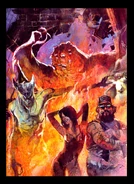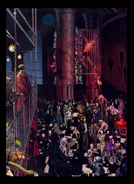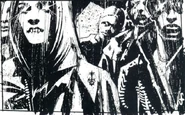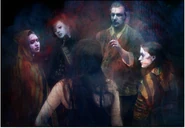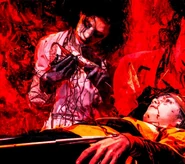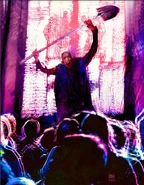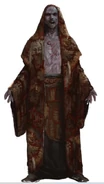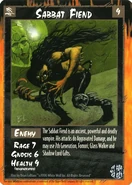- For the Vampire: The Eternal Struggle expansion, see Sabbat (VTES). For the Fifth Edition book, see Sabbat: The Black Hand
The Sabbat is a loose organization of Cainites who reject the Traditions. Unlike the Camarilla, the Sabbat believes in the Antediluvians and Caine. Also known as the Sword of Caine, as they believe they will be the army Caine will use to destroy the Antediluvians once Gehenna arrives.
History[]
The Sabbat was founded in 1493 CE, largely in reaction to the Convention of Thorns which founded the Camarilla. They are the remnants of the Anarch Revolt of the time.
Leaders of the endeavour were the Tzimisce and the Lasombra, two Clans that had ostensibly destroyed their Antediluvian founders and had accepted that there was no turning back for them. The Tzimisce would not cede their lands to the hated Tremere and submit the philosophy of Metamorphosism for the limited ideals of Humanity, while the Lasombra had invested too much in the Revolt to surrender their success to decrepit elders of other Clans (in the words of the Clan representative at the Convention of Thorns: "I came to negotiate, not to surrender."[1]) Delegations of both Clans met at the island of Majorca and began their own negotiations,[2] aided by several malcontents among the Anarchs, who refused to surrender to the Elders or did not share the view of their main Clan. Others joined to escape the practice of the Blood Bond, among them venerable Elders like the Malkavian Vasantasena, the Tremere Goratrix, and the Ventrue Dominique Touraine. These groups existed as small packs in the wilderness that harassed the holdings of the Elders and those who had submitted to the Camarilla, called "Sabbats" by the superstitious mortal population for their rapacious behavior and proud display of their inhumanity. Slowly, these disparate packs were brought to heel by the spreading of the Vaulderie, uniting the remnants of the Anarch Revolt as the Sabbat, a sect devoted to warfare against the Antediluvians and the tyranny of their catspaws.
Bitter war raged between the vampires of the newly formed Sabbat and the not-much-older Camarilla. The Inquisition continued to claim victims while all of Europe's Cainites drew lines in the sand to mark their allegiance. As the Camarilla consolidated their hold on the major European cities, the Sabbat were thrust into the defensive. Within the Black Monastery in Switzerland, the sect formalized the modern Paths of Enlightenment in 1666 out of the old Roads that had become obsolete. Despite open protests against it as a tool of the Antediluvians, the Sabbat Elders realized the worth of secrecy in the modern night and the real danger of falling into Wassail in the face of the demands of the Beast, so they sought to accommodate to these circumstances without pretending to be human.
Besides Spain, which was controlled by a majority of Lasombra, and territories in Eastern Europe and Scandinavia, which were claimed by the Tzimisce, most packs traveled across the sea to the New World. For a while, the sect flourished in the evolving colonies. Amid a revolutionary and radical mortal backdrop, the Sabbat's presence was easy to hide among the insurrectionists, fighting against the Cainite masters of the Aztecs, the dreaded monster Huitzilopochtli and his peers, as well as against the native Lupines.
Civil War[]
The relative prominence of the Sabbat in the Americas faced opposition, though, as disenfranchised Camarilla vampires also journeyed across the oceans, hoping to carve out legacies for themselves away from the ironbound holdings of European princes. Due to a lack of organization within the American packs, internal struggle between the Lasombra and Tzimisce resulted in the events of the First Sabbat Civil War.
The war weakened the sect enough that the Camarilla was able to seize much territory from them, before, after 30 years of conflict, the Purchase Pact officially forbade it to attack other Sabbat members in 1803. Cool heads never prevail in times of war however, and another wave of infighting broke out, which culminated in the Second Sabbat Civil War, a conflict grounded in simmering animosities that still rumbled on beneath the Purchase Pact. Convening in New York, which the sect had managed to hold against all the best efforts of the Camarilla, high-ranking Sabbat reconsidered their commitment to the sect's causes. Not content to merely sign a goodwill agreement as they had before, Sabbat vampires took a long, hard look at what was important to the Sword of Caine. An unheard-of congregation of Sabbat committed to document the Code of Milan in 1933, a collection of tenets that composed Sabbat ideology supposedly since the establishment of the sect. The new Code of Milan was approved by the new Regent Melinda Galbraith, as well as several Seraphim of the Black Hand. It also served to establish Mexico City as the informal capital of the Sabbat.
In the times of struggle, the Sabbat had managed to keep control of some major cities in the United States even through the internal war. Some cities, such as Philadelphia, remained under Sabbat domination because the Black Hand centralized most of its number in these locations. The Dioceses in Europe remained untouched by the upheavals overseas. The Sabbat began to develop along two lines - city Kindred and nomadic Kindred. Many of the nomadic packs were Sabbat that fled their cities after defeat at the hands of the Camarilla or other Sabbat. The city Kindred maintained permanent havens and and further resembled their Camarilla counterparts in that they inserted themselves in the local infrastructure of the city, while the nomadic Kindred traveled all over the country, never existing in one place too long and upholding the old tenets of the ancient Anarchs.
The Third Sabbat Civil War, the briefest of the three, lasted only 100 nights, in the latter half of 1957. Incited by a failed coup of New York on behalf of the Brujah antitribu, violence once again ensued. Ironically, the end of the trouble came as a result of the rarest of Cainite diplomacy-compromise. After the Brujah antitribu coup fell, the clan rose against the united Lasombra and Tzimisce, which was bound for disaster. Out of the ashes of the fighting, however, emerged a unified group of Caitiff calling themselves the Panders, after their leader, Joseph Pander. The Panders had the support of the Brujah antitribu, as they were rabble and outcasts, much like the Brujah had become after the migration to the New World. Seeing the opportunity to avoid another protracted (and dreadfully embarrassing) war, the Lasombra and Tzimisce recognized the Panders as a distinct entity, conferring on the group clan or bloodline status.
Modern Nights[]
In the Modern Nights, the Sabbat has undertaken great offensives against the Camarilla, but also faced several internal crises. Atlanta and Washington, D.C. have fallen to their hands, but they lost New York City and Milan. The destruction of the Tremere antitribu and the attacks against mexican Sabbat holdings by unknown perpetrators have been damped by the arrival of new allies, the Salubri antitribu and the Harbingers of Skulls, who joined the Sabbat to exact vengeance against their enemies. The Black Hand, once a bastion of stability, shakes with the destruction of the infiltrators of the "True" Black Hand, as two Seraphs vanished and several Assamites abandoned the sect to return to Alamut under the leadership of Ur-Shulgi. Tensions between the Sabbat elders of the Old World and those of the New World arise. The Regent has been slain, although this is known only by the Cainite who impersonates her until the charade will be revealed.
V5 Timeline[]
| “ | I can't help but think of all the blood shed in Africa and the Middle East for this Gehenna Crusade, all the Cainite lives lost, of how we celebrated the one in twenty vampires who returned from conflict with a Methuselah, bloated like a tick on new power. We just forgot the nineteen fallen and where their vitae went. Who it fed. Who or what the ashes of Methuselahs summoned to the surface.[3] | ” |
After the rise of the Second Inquisition and the start of the Gehenna Crusade in the Middle East, the Sabbat has (seemingly) given up on controlling the cities of America and flocked to the war zones of the world. However, most Sabbat domains are still out-of-bounds to the Camarilla. A "Gehenna War" between the Camarilla and the Sabbat is being waged in the Middle East and the disputed regions of Ukraine. The conflict began as the majority of the Sabbat abandoned most of its domains to wage what they perceive to be a pre-emptive "crusade" against the coming Antediluvians. In response to this aggression, the Camarilla began fighting them back in order to preserve the Masquerade and to protect torpored methuselah from any Sabbat war parties who may confuse them for Antediluvians.
The Chicago Folios also gives some information about Sabbat. Chicago, for all its corruption and horrors, understands though it may wallow in degradation, it has nothing on the empire of perpeturbation that is the Sabbat. The city has had many horrific encounters with the fanatical sect, most recent being the dread nights of 1993. Little is known about the fringe and alien sect. What is known is the Sabbat relinquished control over its holdings and threw itself into a purported "Gehenna War." With the advent of the Lasombra defection, there have been whispers of concern about what the Sabbat will do in retaliation. To help the Lasombra in their quest to join the Camarilla is to potentially put a target for the Sabbat on your back. The Chicago Sabbat have become a cell organization, perpetuating atrocities by some byzantine design. These cells have become known as "The Seven Fires" - the surviving cells not called off to the Gehenna War, destroyed by Edward Neally, or killed by the defecting Lasombra. This is likely a name given to them due to their ferocity, related to their brutal "ritae", often connected to fire, their appalling "games", or something to do with their numbers of operatives or groups known as packs. The Seven Fires leave nothing but carnage and perplexing propaganda in their wake. In their graffiti, their trail of mutilated bodies, and arcane scrawl, they reference the story of Peter Pan, possibly an allusion to the Lasombra defection and "losing their shadow". These Cainites are appearing close and closer to Chicago border, emerging in more run down or economically suburbs. What befell the Sabbat in the United States is still broadly a mystery. Packs disappeared, the hierarchy dissolved, and many of the Cainites remaining in place lost their grip on reality and stability as their purpose disappeared.
While most Kindred try to resist the Beckoning, Sabbat vampires go towards it. In the Sabbat: The Black Hand, it's revealed that the Gehenna War is not only focused in the East, but all over the world.
Culture[]
The Sabbat has many ways of identifying its members: the sect has an official color (purple), an official symbol (an inverted ankh), and dozens, if not hundreds, of specific signs, passwords, and gestures that theoretically let one member identify another. In practice, few Sabbat can recognize more than a few of these signs - most learn to identify one another by face at ritae or other sect gatherings.
Typically only a Bishop or Archbishop will be able to positively identify any vampire in their domain as Sabbat or non-Sabbat - in the case of nomadic packs, even this becomes a chore. Additionally, each of the individual packs of the Sabbat can assume their own particular symbol, gesture, or other way of identifying themselves. Pack members who are undercover have even more obscure and hard-to-spot ways of making their identities known or passing along information.
It has become quite the affectation among younger Sabbat (particularly those of Clan Lasombra) to wear crucifixes somewhere on their person - a necklace, an earring, even a tattoo. The irony of being damned but bearing the symbols of salvation is a source of great amusement to these vampires, especially if the bearer is a pack "priest". Older, more mature Lasombra regard the practice as irritating or outright blasphemous, even if they wear such a cross themselves. Their argument is that the neonates do not believe in their own damnation, or in God's immortal power over their souls.
Many neonates in the sect wonder why they have to bother with all these trappings of espionage: is not the Sabbat's mission statement to tear down the Camarilla and its Masquerade and rule humans openly? Sabbat elders who lived through the Inquisition do not dignify these questions with an answer, and even bishops are hard-pressed to come up with a convincing response.
The typical attitude is that being a True Sabbat is a matter of importance and distinction – you do not want just anybody coming in and claiming all the rights and privileges of Sabbat without having proven themselves first. Also, given the pack structure of the sect, many members think of themselves as a collection of gangs or neo-feudal warbands, complete with initiation rites and other ways of making themselves feel special.
The higher up one goes in the Sabbat ranks, the less frequently such symbols are seen, and the "us against the world" outlook of the young packs becomes more and more "me against the world". In order to survive long enough to achieve position and age within the sect, a vampire must learn how to live for themselves, and to fight for every scrap of profit or slightest advantage. Unlike the Camarilla, there is no rigid hierarchy in place to promote or control the ambitions of Sabbat vampires – the only rank and title a Sabbat holds is what they have the power to take.
Both the Tzimisce and the Lasombra encourage this dog-eat-dog culture, as it seems to ensure that only the strongest, smartest, and most capable lead the sect, and all the rest are fodder for the appetites of their betters. The only time Monomacy can be suspended is during a Crusade, and even then, all the reckless charges and Wild Hunts tend to have a way of weeding out the slow and weak from the Sabbat's ranks.
Countering this anarchic atmosphere is the Vaulderie. There are still a few elders who, in nights past, were members of the same pack, and will occasionally work together and share the Vaulderie. Younger vampires, who are living and fighting together as one unit, develop a fierce protection of one another, or else. If you cannot rely on your packmates, or their loyalty is in question, then the only thing stopping them from being ripped to shreds is the Vinculum bond they share with the rest of the pack. In the World of Darkness, being part of a pack is sometimes the only thing these vampires have going for them.
Ritae[]
| “ | In nomine Caine; et Patris, et Gladius, et Sanguis Sancti... | ” |
| — Sabbat doctrine[4] | ||
The Sabbat values its bonds of loyalty and fraternity above all else. To this end, the sect has established many rituals, which reinforce pack and sect solidarity and structure. The entire sect observes the same 13 Auctoritas Ritae , while the Ignobilis Ritae vary greatly in number, subject and observation from pack to pack. The official corpus of ritae, as well as their authenticity and orthodoxy, is scheduled during Synods of high-ranking Noddists.
Packs observe the auctoritas ritae at common times: at esbats, before sieges, or when bringing a new member into the pack, for example. The ignobilis ritae may occur at any time, usually when the pack priest believes them to be most appropriate. Some packs observe greeting or parting ritae, feeding ritae, ritae of diablerie and any number of variations.
Most ritae exalt the vampiric state and are striving for perfecting it – as a result, these ritae are especially cruel to mortals and kindred alike. Many Ritae have shamanistic or even koldunic origins.
Organization[]
The Sabbat sees itself as the army of Caine and consequently is tightly organized, far more than the relatively anarchic Camarilla. The Sabbat consists mainly of Clans Tzimisce and Lasombra and numerous antitribu from Clans normally independent or associated with the Camarilla.
Although Sabbat vampires may sire childer as usual, and are no less picky than any other vampire about it, during a war effort, they often backdrop to use Mass Embraces for a steady supply of shock troopers. These unfortunate vampires are knocked over, Embraced and buried. By the time the so-called "shovelhead" has clawed himself up, he is usually confused and aggressive and then directed with the rest of the Mass Embrace in a first vinculum against the enemy. Most shovelheads do not survive their first weeks, they are considered False Sabbat and are not respected in any way by the members of the sect. Once they have proven themselves repeatedly, they are usually introduced into the sect and undergo the Creation Rites to become True Sabbat. Childer who are specifically chosen to be Embraced often receive this instructions much earlier directly from their sire.
The cornerstone of Sabbat organization is the pack; Sabbat packs are organizations of 3-10 vampires mutually bound through the standard blood-sharing rites of the cult. Packs have a ductus, who is the pack's warleader, and a pack priest who reminds the pack of its responsibilities to Caine. In addition, pack members are mutually bound in a vinculum – a sort of communal blood bond – created by the blood-sharing ceremonies. Packs generally occupy communal havens; given the Sabbat's rejection of human mores and its use of artificial loyalties enforced by the vinculum, there is less need for privacy.
Hierarchy[]
Above the pack is a set of hierarchical titles specifically mocking the titles of the Catholic Church. Bishops oversee multiple packs and may also have a specific portfolio; overseeing Bishops are Archbishops, generally holding a position analogous to Prince for a city. Above the Archbishops are the Cardinals, who oversee large geographic regions (such as Canada, or the Eastern Seaboard) and who comprise the Consistory, the governing body that selects the Regent. Advising the Regent, Consistory, and Archbishops, or other leaders are the Prisci, a group of elders and other respected Sabbat who take an advisory and judicial role. The higher ranks of the Sabbat enforce their will through agents commonly called Templars or Paladins, depending on rank.
- Sabbat Political Hierarchy
- False Sabbat
- True Sabbat
- Ductus
- Pack Priest
- Templar (or Paladin)
- Bishop
- Archbishop
- Priscus
- Cardinal
- Regent
These titles are formally recognized, but also generally involve a certain degree of self-selection. The Sabbat has a formal rite for recognizing Bishop and higher ranks, but any Sabbat may claim a title and try to defend it. However, the higher the rank claimed, the more likely the claimant will meet a gruesome end. The Prisci, in particular, are selected only by other Prisci.
As with all Vampiric organizations, organization eventually bows to the demands of power. While most Sabbat belong to packs, elder Sabbat are more likely to live and work without packmates. At the higher levels of the organization, the difference between Camarilla and Sabbat elders is negligible, regardless of how different it may appear in the trenches.
Factions[]
The Sabbat is a fractious lot that values personal freedom above everything else. In the chaos of the Sabbat, it is not unlikely to find members of these factions among the packs, though by no means does every member of the Sabbat support a faction.
- Loyalists: On the far left side of the political spectrum, supporters of the Loyalists see themselves as heirs to the original Anarchs. They believe that the only way to be loyal to the Sabbat is to follow the original principle of the Anarch Movement - that all vampires must be free and ultimately responsible for their own actions. They are strongly opposed to the Code of Milan and the Purchase Pact.
- Moderates: Not as radical as the Loyalists, the Moderates see the modern Sabbat as clogged with rules and regulations that are in contrast to the original spirit of the Anarch Revolt. They support the Purchase Pact, but oppose several tenets of the Code of Milan.
- The Status Quo: The Status Quo literally seeks to keep things the way they are and work within their current systems, believing that allowing members a looser rein will compromise the secrecy and security of the sect. They support the Purchase Pact and the Code of Milan in its current form.
- The Orthodoxy:[5] The Orthodox Sabbat advocate a strengthening of the religious aspects in the higher echelons of the Sabbat, believing that to do otherwise would invite divine ire. They advocate a no-quarters attitude to heretics, as well as a reinforcement of the position of the Pack priest over the Ductus.
- Ultra-Conservatives: The far-right wing of the sect, the Ultra-Conservatives believe that Gehenna is just around the corner and that the sect must be ready for war. In their eyes, even the Revised Code of Milan goes not far enough to unite the sect.
Other groups are the Elders of the Old Clan Tzimisce, who joined with the Sabbat mainly to have their peace and not be bothered by pestering fledglings, the Pander Movement, charmingly referred to as "total political whores", who support any faction that supports them or anyone who helps them increase their “legitimacy”, and the Order of St. Blaise, a clerical order within the ranks of the Catholic Church that serves as the Sabbat's liaison to the Catholic clergy.
In addition to these factions, two parallel organizations exist within the Sabbat. The Sabbat Inquisition investigates vampires within the Sabbat for any signs of demon worship or apostasy. Contrasting, the Black Hand is a militant sect within the sect, and operates semi-independently from the Sabbat that it predates.
Heresies[]
Absolute freedom is not used wisely by everyone. Packs are seduced by the false teachings of the Path of Lilith or other Paths of Enlightenment that preach subservience to the Fathers, like the Path of Typhon or the Path of Blood. Others fall to the temptations of Infernalism, sometimes through the Path of Evil Revelations, sometimes through misplaced ambition and curiosity. The Sabbat Inquisition works hard to bring these heretics to justice, but the widespread nature of nomadic packs makes a complete eradication of heretics difficult. Some dioceses harbour heretics without knowing, who then spread their teachings to unsuspecting Shovelheads. Because these groups threaten the Faith that is one of the cornerstones of the sect, they are dealt with harshly.
Gallery[]
References[]
- ↑ VTM: Guide to the Anarchs, p. 19
- ↑ VTM: Clanbook: Tzimisce Revised, p. 22
- ↑ [citation needed]
- ↑ VTM: Rites of the Blood, p. 33
- ↑ VTM: Rites of the Blood, p. 48
- VTM: Vampire: The Masquerade, p. 183, 195
- VTM: Vampire: The Masquerade Second Edition, p. 44, 55
- VTM: Guide to the Sabbat
- VTM: Storytellers Handbook to the Sabbat
- VTM: The Players Guide to the Sabbat
- VTM: Sabbat: The Black Hand
| Vampire: The Masquerade Sects | |
|---|---|
| Current
|
Anarch • Ashirra • Camarilla • Hecata • Sabbat (Black Hand) |
| Legacy
|
Inconnu • Independent Clans • Lost Tribe • Tal'Mahe'Ra |
| Mind's Eye Theatre
|
Independent Alliance |




